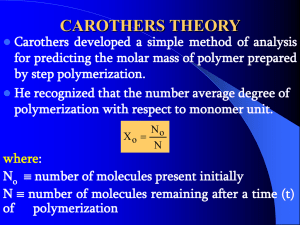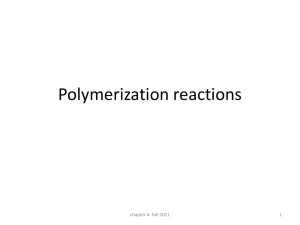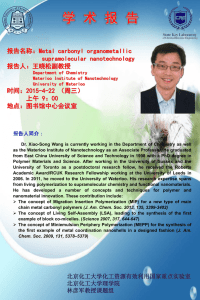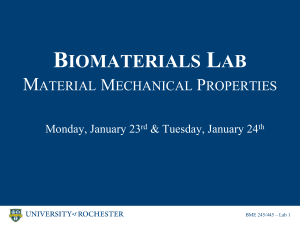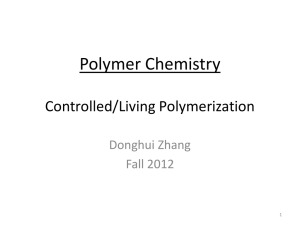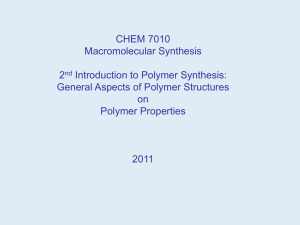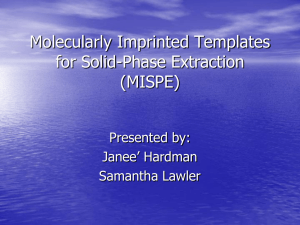Chapter 2c - Loy Research Group
advertisement
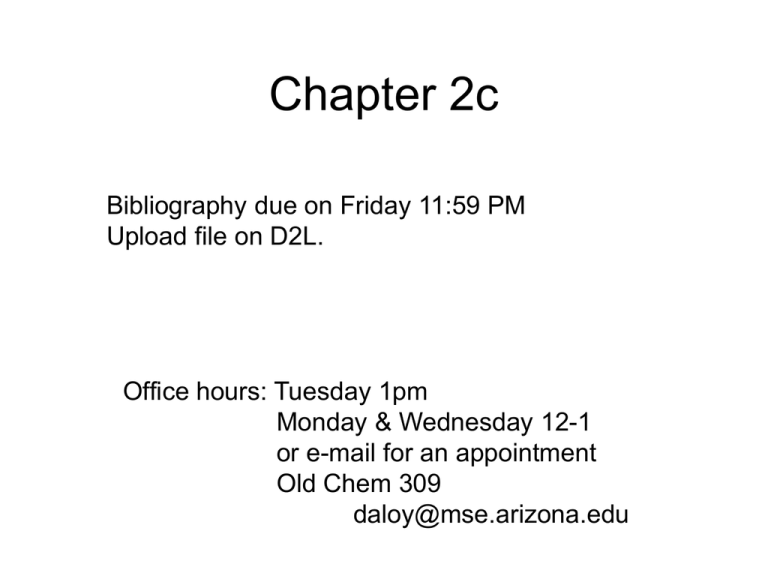
Chapter 2c Bibliography due on Friday 11:59 PM Upload file on D2L. Office hours: Tuesday 1pm Monday & Wednesday 12-1 or e-mail for an appointment Old Chem 309 daloy@mse.arizona.edu Polymerization Techniques • Bulk-no solvent just monomer + catalysts • Solution Polymerization-in solvent • Suspension-micron-millimeter spheres • Emulsion-ultrasmall spheres Bulk Polymerizations Rare Overheat & explode with scale up No solvent-just monomer Polymer usually vitrifies before done Broad MW distribution Acrylic sheets by Bulk polymerization of MMA Storage of vinyl monomers in air = peroxide initiated polymerizations Tankcar of styrene 2005 in Ohio Solution Polymerization • Better control of reaction temperature • Better control of polymerization • Slower • Not very green-residual solvent Suspension Polymerization • Oil droplets dispersed in water • Initiator soluble in oil • Greener than solution polymerization Filter off particles of polymer Emulsion Polymerization Still oil in water (or the reverse) Initiator in water Smaller particles (latex) Excellent control of temp Solution turns white Polystyrene latex Suspension Monomer in oil Initiator in oil Emulsion Mini-emulsion Monomer in oil Monomer in oil Initiator in water Initiator in water Micro-emulsion Monomer in oil Initiator in water Less Common Polymerization Techniques • Solid state polymerization – Polymerization of crystalline monomers • Diacetylene crystals • Gas Phase polymerization – Parylene polymerizations • Plasma polymerization – Put anything in a plasma Solid State Polymerizations Heating Oligomeric Condensation Polymers Tg < X < Tm O O O HO O O O O O n O OH HO OH O O 250 °C O Tg = 67 °C and Tm = 265 °C Nylons, Polyesters Nylon 66 Tg = 70 °C and Tm = 264 °C O O O O n O Solid State Polymerizations Topological Polymerizations: Polymerization of crystals Quinodimethane polymerizations Di- and Triacetylene polymerizations In single crystals Solid State Polymerizations of Fullerenes Topological polymerization in 3-D Gas Phase Polymerization 1) Light olefins 2) Parylenes LIGHT OLEFINS Ethylene and propylene Rotational Molding 1% Blow Molding 14% Other Extrusion Wire and Cable 2% 3% Pipe and Conduit 7% Sheet 2% Extrusion Coating 4% Film • Food Packaging • Hygiene & Medical • Consumer & Ind. Liners • Stretch Films • Agricultural Films • HDSS Injection Molding 12% Other Non-Extrusion 3% Film 51% 2004 Global PE Demand: 136 Billion Pounds Types of Polyethylene HDPE (0.940-0.965) “High Density” LLDPE (0.860-0.926) “Linear Low Density” O O O C-OH O O O LDPE (0.915-0.930) “Low Density” O O O O O High Pressure Copolymers (AA, VA, MA, EA) Gas Phase Polymerization: Light olefins Oxygen initiator 2-3K atmospheres 250 °C Gas Phase Polymerization: Light olefins Fluidized bed polymerization MORE FLEXIBLE Gas Phase Polymerization: Paralene Gas phase Polymerizes on contact Conformal coatings Pinhole free Preserving artifacts (paper) Microelectronics Medical devices Plasma Polymerization •500 Å - 1 micron thick films •Continuous coatings •Solvent free •High cohesion to surface •Highly cross-linked •Generally amorphous Plasma Polymerization Monomers: Hydrocarbons Double or triple bonds nice, not necessary Fluorocarbon Tetraalkoxysilanes (for silica) Plasma Polymerization Fig1. Bell-jar type reactors Fig 2. Tubular-type reactors P- pumps; PS-power supply; S-substrate M-feed gas inlet; G-vacuum gauge Plasma Polymerization Multi-layer bottles No loss of fizz PET [Poly(Ethylene Terephthalate)] Characterization of Polymers • 1H & 13C Nuclear Magnetic Resonance spectroscopy (NMR) • Infrared spectroscopy (Fourier Transform IR) • Elemental or combustion analyses • Molecular weight 13C NMR is a very powerful way to determine the microstructure of a polymer. 2 1 1 2 13C NMR shift is sensitive to the two stereocenters on either side on sptectrometers > 300 MHz. This is called pentad resolution. r m m r m r mmrm pentad m = meso (same orientation) r = racemic (opposite orientation) 13C NMR spectrum of CH3 region of atactic polypropylene Infrared Spectroscopy: Bond vibrations C=C-H polystyrene C-H C=C stretch 2-16 Micron wavelength range Infrared Spectroscopy: Bond vibrations C-H bend C=O C-O C-H stretch Poly(methyl methacrylate) Types of Addition Polymerizations Anionic Ph C3H7 Li n Li+ C4H9 Ph Li+ C4H9 n Ph Ph Ph Radical PhCO2• Ph n Ph PhCO2 n Ph Cationic Ph Cl3Al OH2 PhCO2 Ph Ph n Ph H HOAlCl3 H Ph HOAlCl3 n Ph Ph Chemical Modification of Polymers 1) Hydrolysis polyvinyl alcohol Polyvinylacetate NaOH n O O 2) Oxidation n O H3C OH H2O O n CH3 Poly ethylene oxide O hv, O2 O H 3) Photochemistry (can be oxidation or not) 4) Chemical crosslinking Na+ Me n Polysilane R R R R Si Si Si Si Si R R R R R R H h: UV O2 S8 polybutadiene 5) Chemical modification See next slide H or ascorbic acid R R O Si R Si O R O Si R Si O R R R S S S Chemical Modification of Polyvinyl Alcohol to make Polyvinyl butyral for safety glass polyvinyl alcohol poly vinyl butyral CH3CH2CH2CHO OH OH OH O OH OH O OH O No PVB With PVB O Bullet Proof Glass Making bullet proof glass glass, laminates and polycarbonate sheets are interlaid in a clean room to ensure clarity. In our large autoclave, superheated steam seals the layers together. Polycarbonate is Strong Material Young's modulus (E) Tensile strength (σt) 2-2.4 Gpa 55-75 Mpa Exploding CD’s Mythbusters: > 23,000 rpm CD will shatter Scratches or defects are the culprit 52X drive -MAX: 27,500 rpm typical: 11,000 rpm 10,000 RPM = 65 m/s = 145 mph 7200 gravities of acceleration And approx. 5 MPa stress Yield Strength 60 MPa Nalgene Polycarbonate Properties Density: Young's modulus (E) Tensile strength (σt) Elongation (ε) @ break Glass transition (Tg) Melting (Tm) Upper working temperature $7.3-11/kg 1.2 g/cc 2-2.4 Gpa 55-75 Mpa 80-150% 150 °C 267 °C 115-130 °C Bisphenol and Endocrine System 100-250 g bisphenol per Liter water in water bottles 20 g/Liter per day can disrupt mouse development vom Saal, F.S., Richter, C.A., Ruhlen, R.R. Nagel, S.C. and Welshons, W.V. Disruption of laboratory experiments due to leaching of bisphenol a from polycarbonate cages and bottles and uncontrolled variability in components of animal feed. Proceedings from the International Workshop on Development of ScienceBased Guidelines for Laboratory Animal Care, National Academies Press, Washington DC, 65-69, 2004. Immune system Antioxidant enzymes Decreases plasma testosterone Learning disabilities vom Saal, F.S., Nagel, S.C., Timms, B.G. and Welshons, W.V. Implications for human health of the extensive bisphenol A literature showing adverse effects at low doses: A response to attempts to mislead the public. Toxicology, 212:244-252, 2005. Nalgene Substitutes-food and water • • • • Glass (blender, pitchers, glasses) Metal (water bottles) Polyethylene (water bottles) Polyamide or Nylon (baby bottles)


